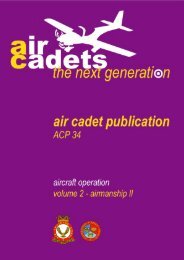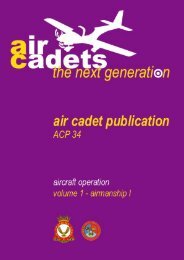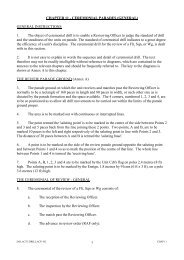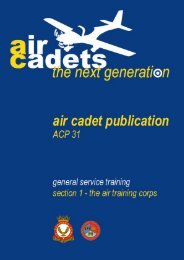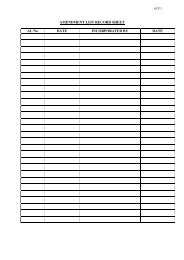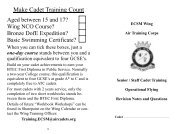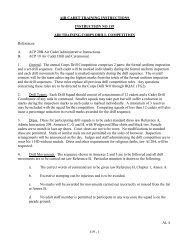Leading Cadet ECSM Wing Revision Guide - 967 Air Cadets
Leading Cadet ECSM Wing Revision Guide - 967 Air Cadets
Leading Cadet ECSM Wing Revision Guide - 967 Air Cadets
Create successful ePaper yourself
Turn your PDF publications into a flip-book with our unique Google optimized e-Paper software.
What is the angular difference between true north and<br />
magnetic north called?<br />
a) Magnetic deviation.<br />
b) Magnetic variation.<br />
c) Magnetic differential.<br />
d) Compass error.<br />
The angular difference between grid north and magnetic<br />
north is:<br />
a) Magnetic difference angle.<br />
b) Magnetic variation.<br />
c) Grid variation.<br />
d) Grid magnetic angle.<br />
e) Grid deviation angle.<br />
f) Compass deviation angle.<br />
g) Magnetic deviation angle.<br />
Where, on an M726 OS map is the information on magnetic<br />
variation located?<br />
a) At the top of the map.<br />
b) At the bottom of the map.<br />
c) At the extreme left of the map.<br />
d) On the back of the map.<br />
What information is provided at the bottom of an M726<br />
OS map?<br />
a) Sheet number.<br />
b) Magnetic variation.<br />
c) Grid magnetic angle.<br />
d) Abbreviations.<br />
Where is information on the grid magnetic angle located<br />
on an M726 OS map?<br />
a) At the centre of the bottom margin.<br />
b) At the centre of the top margin.<br />
c) In the extreme left hand side of the map.<br />
d) On the back of the map.<br />
How many Norths do we have to consider when using an<br />
Ordnance Survey map?<br />
a) 1 b) 2<br />
c) 3 d) 4<br />
There are many types of flaps, but when selected<br />
down they all increase the effective camber of the<br />
wing and hence its lift.<br />
W Clean <strong>Wing</strong><br />
X Simple Flap<br />
Y Split Flap<br />
Z Fowler Flap<br />
Fig 5<br />
If full (90°) flap is selected for an approach to<br />
land, drag is significantly increased and the<br />
steeper approach angle gives the pilot a better<br />
forward view. The lower approach speed also<br />
gives a reduced touch-down speed and a shorter<br />
landing run.<br />
For take-off, a small amount of flap (about 15°)<br />
will improve lift at take-off speeds and shorten the<br />
take-off run with only a very small drag penalty.<br />
Slats<br />
Slats are another device which designers may fit<br />
to improve handling at low speeds.<br />
Fig 6<br />
R - Slat S - Slot T - <strong>Wing</strong> Section U - Flap<br />
Positioned along the leading edge of the wing,<br />
slats are opened at slow speeds enabling air to<br />
flow through the slot between the slat and the<br />
wing. This smoothes the airflow over the wing.<br />
Instead of stalling at the usual 15° angle of attack<br />
the wing can reach as much as 25° before stalling<br />
and the stalling speed is very much reduced.<br />
Slats do cause some extra drag, so most are designed<br />
to close automatically at lower angles of<br />
attack.<br />
See figure 5. Which of these is a split flap?<br />
a) W b) X<br />
c) Y d) Z<br />
A pilot selects full flap when coming in to land. This will:<br />
a) Reduce the angle of approach and improve the forward vision.<br />
b) Increase the angle of approach and improve the forward vision.<br />
c) Decrease the angle of approach and reduce the landing run.<br />
d) Increase the angle of approach and increase the landing run.<br />
Which of the following will occur when flap is lowered during the<br />
approach to land?<br />
a) Stalling speed will be increased.<br />
b) Lift will increase.<br />
c) A higher touch-down speed will be needed.<br />
d) Drag will be reduced.<br />
Which of these flap settings would a pilot most probably select for a<br />
shorter take off?<br />
a) 120 degrees. b) 90 degrees.<br />
c) 60 degrees. d) 15 degrees.<br />
To obtain maximum drag from an aircraft's flaps, they should be set<br />
to:<br />
a) 10 degrees. b) 30 degrees.<br />
c) 40 degrees. d) 90 degrees.<br />
What is the purpose of a slat on an aerofoil?<br />
a) To improve handling at high speed.<br />
b) To reduce drag at high speeds.<br />
c) To make the air turbulent at low speeds.<br />
d) To improve handling at low speeds.<br />
Which of these describes the effect of slats at low speeds?<br />
a) Generate extra turbulence in the airflow over the wing.<br />
b) Help the pilot to move the control surfaces into the airflow.<br />
c) Make it more difficult for the pilot to move the control surfaces<br />
into the airflow.<br />
d) Smooth out the turbulence in the airflow over the wing.<br />
When slats are open on a wing, what effect will this have on i) the<br />
stalling angle, and ii) the stalling speed?<br />
a) Increase Increase<br />
b) Reduce Increase<br />
c) Increase Reduce<br />
d) Reduce Reduce<br />
When slats are open on a wing, what effect will this have on the<br />
drag?<br />
a) No effect.<br />
b) Decrease it.<br />
c) Increase it.<br />
d) Reduce it to zero.<br />
See figure 6. On this cross section of a wing, which arrow points to<br />
a slat?<br />
a) R b) S<br />
c) T d) U<br />
See figure 6. On this cross section of a wing, which arrow points to<br />
a flap?<br />
a) R b) S<br />
c) T d) U<br />
30<br />
11



